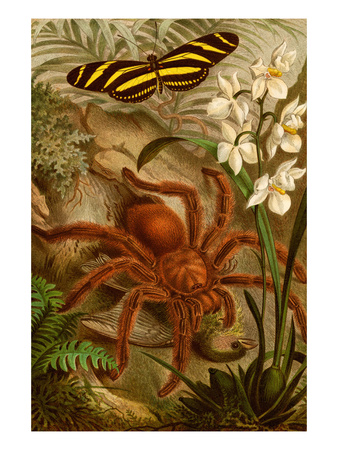General distribution of tarantulas
drawn after World Spider Catalog 7.0, maintained until 2014 by Norman Ira Platnick (December 30, 1951-April 8, 2020): Sarefo, CC BY SA 3.0, via Wikimedia Commons @ https://commons.wikimedia.org/wiki/File:Distribution.theraphosidae.1.png
When predator becomes prey: Tarantula is skewered on Mojave yucca (Yucca schidigera) spike by loggerhead shrike (Lanius ludovicianus) in southeastern California's Joshua Tree National Park.
New World native passerine birds, Loggerhead Shrikes turn the table on prey, including tarantulas, by impaling them on sharp points such as barbed wire, spikes, or thorns.
photo by Brad Sutton/National Park Service (NPS): Joshua Tree National Park, Public Domain, via Flickr @ https://www.flickr.com/photos/joshuatreenp/14045718200/
Unlike Old World species, New World tarantula species have evolved irritating barbed hairs, known as urticating bristles, on opisthosoma for defense.
Opisthosoma is the posterior body part, often likened to an abdomen, but distinctive in arthropods for its inclusion of respiratory organs (book lungs or book gills) and the heart.
adult female Mexican Red-Kneed Tarantula (Brachypelma smithi) with bald patch on opisthosoma from kicking off urticating bristles: HTO, Public Domain, via Wikimedia Commons @ https://commons.wikimedia.org/wiki/File:Brachypelma_smithi,_urticating_hairs.JPG
Brazilian Giant Whiteknee Tarantula (Acanthoscurria geniculata): New World tarantula; fast-growing mature legspan of 8.5 inches (21.5 centimeters) for females
Native to forests of Brazil, A. geniculata are prized as pets!
macro of Brazilian Whiteknee Tarantula (Acanthoscurria geniculata): Flickpicpete (Thanks for 780,000+ views), CC BY ND 2.0, via Flickr @ https://www.flickr.com/photos/flickpicpete/12075195475/
Tarantulas meet their match in nature: Female tarantula hawk or spider wasp (Pepsis or Hemipepsis) drags paralyzed Mexican Red-Kneed Tarantula (Brachypelma smithi).
Bajos del Toro, Alajuela province, north central Costa Rica: Charles James Sharp (Charles J. Sharp), CC BY SA 3.0, via Wikimedia Commons @ https://commons.wikimedia.org/wiki/File:Wasp_with_Orange-kneed_tarantula.JPG
Fried tarantulas have become a delicacy in Cambodia, centered in Skuon, known touristically as Spider Village, in Kampong Cham Province, southeastern Cambodia.
fried tarantula in Cambodian restaurant: Jaiprakashsingh, CC BY SA 3.0, via Wikimedia Commons @ https://en.wikipedia.org/wiki/File:Fried_Tarantula_in_Cambodian_Restaurant.jpg














 Are Hawaiian Huakai Po Nightmarchers Avenging Halloween Thursday?on 10/02/2024
Are Hawaiian Huakai Po Nightmarchers Avenging Halloween Thursday?on 10/02/2024
 Mailing Addresses for 2023 Form 4868 Extending 1040 and 1040SR April 15, 2024, Due Dateon 04/15/2024
Mailing Addresses for 2023 Form 4868 Extending 1040 and 1040SR April 15, 2024, Due Dateon 04/15/2024
 Mailing Addresses for 2023 Forms 1040 and 1040SR Filed in 2024on 04/15/2024
Mailing Addresses for 2023 Forms 1040 and 1040SR Filed in 2024on 04/15/2024
 Mailing Addresses for 2022 Form 4868 Extending 1040 and 1040SR April 18, 2023, Due Dateon 04/13/2023
Mailing Addresses for 2022 Form 4868 Extending 1040 and 1040SR April 18, 2023, Due Dateon 04/13/2023



Comments